Happy anniversary, Johnchidleyhill.com!
Last Tuesday was the one-year anniversary of this blog's creation. For the past year this website has been a place to work on my writing, talk about things that interest me and show off my various professional projects.
I’ve been really pleased with this site and with how my career has developed over the past year. In particular, I’ve been touched by all the positive feedback I’ve received from people. I’m always surprised with how often friends or family mention that they love my writing here. It’s nice to see my hard work appreciated like that.
To me, the most incredible thing about this blog is all the people who’ve read my posts that I don’t know personally. According to my metrics, I’ve had 16,688 unique visits and counting. When I started this site a year ago I never thought I’d have that many visitors.
Thank you for all your support.
To celebrate this blog’s anniversary I thought I’d list the top five most popular articles on this website.
But before I do, I want to mention two in particular: "Bill Simmons’ Twitter idea might be a game-changer" and "Sandwich Review: KFC’s Double Down". These two posts are the two biggest spikes in readership I’ve had over the course of the year. In both cases my readership doubled or even tripled the day they were posted.
Here are the top five most read articles of JCH.com over the past 365 days, in ascending order:
5. "Bill Simmons’ Twitter idea might be a game-changer" – May 14th, 2010
As mentioned above, this article was one of the first big spikes in traffic this blog saw. Collecting a total of 202 unique page views since it was first published, this was my first serious stab at discussing the evolving role of media in sports.
“An interesting experiment occurred on Thursday night as the Boston Celtics eliminated the Cleveland Cavaliers from the National Basketball Association’s Eastern Conference semifinal with a 94-85 victory.
As league MVP LeBron James stepped up to the free throw line in the second half the Boston crowd began to chant “New-York-Knicks! New-York-Knicks!”, referring to one of the more moribund destinations that the soon-to-be free agent might head to in the offseason.
Later, the Celtic faithful began to chant “MSG! MSG!”, the acronym for Madison Square Gardens, the home of the Knicks.
This was all part of a grand scheme concocted by ESPN.com’s Bill Simmons, Boston’s most famous sports fan, and it may just revolutionize spectatordom.”
4. "Sandwich Review: KFC’s Double Down" – Oct. 19th 2010
I’ve reviewed a lot of things on this blog: comics, books, the occasional movie and even some baseball stadiums. But my look at the controversial Double Down sandwich at KFC was the first and last crack at being a foodie you’ll ever seen in this space. That review was particularly timely, earning some buzz and a spike in readership, eventually tallying 214 reads.
“It took months to make it possible, but yesterday I finally ate a Double Down from KFC.
Normally, reviewing a sandwich is not my bag. After all, my good friend and neighbour John already does a bang-up job over at In Search of a Sandwich. Why would I want to compete?
But the Double Down - KFC’s bacon, sauce and cheese sandwich that substitutes the bread for pieces of deep-fried chicken - transcends a normal sandwich. Just as the Double Down pushes the envelope of sandwich technology, I must expand my blogging horizons for this fast food delicacy.”
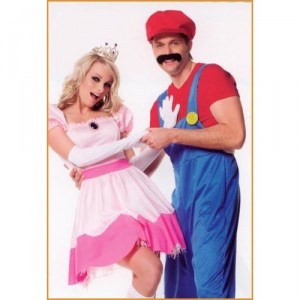 3. "Three ice dancing performances I’d like to see" – Feb. 23rd 2010
3. "Three ice dancing performances I’d like to see" – Feb. 23rd 2010
I blogged throughout the Vancouver Olympics, usually in response to a significant event at the games. By far, the most popular of these pieces was my suggestion for three ice dancing routines that would set the performers apart from the cliché-laden pack.
When I posted this link on Twitter it was quickly picked up and retweeted by many of my friends, making it as close to viral as this site has ever been. That buzz resulted in a total of 313 views to date.
Oddly, and somewhat creepily, “Princess Peach” is by far the most popular search on this website, all thanks to this article.
“Like many Canadians, I was thrilled by Tessa Virtue and Scott Moir’s gold medal ice dance performance on Monday night.
I would never call myself a figure skating or ice dancing fan – I find that too often the judge’s decisions are political – but I was impressed with the athleticism and technique of all the dancers in the competition.
What did not impress me was their lack of creativity or originality. Most of the performances bled together. Virtue and Moir stood above the rest of the competition because they didn’t rely on clichéd music like the themes from the Phantom of the Opera or Requiem for a Dream. They weren’t covered with sequins and feathers. Their performance truly distinguished them from the rest of the pack.”
2. "Toronto has two strikes against it for most professional athletes" – Mar. 9th 2010
I wrote this piece between Roy Halladay’s departure to the Philadelphia Phillies and the National Basketball Association’s free agency period that saw Chris Bosh take his talents to South Beach.
It’s a topic I’d like to revisit sometime, especially since one of my commenters pointed out that my math on the differences in taxes between the United States and Canada might be wrong. Despite the possible error, this post has been read 417 times.
“This summer could be particularly heart-breaking for fans of the Toronto Raptors as they face the prospect of forward Chris Bosh, arguably the best player the team has ever seen, leaving the city as a free agent.
Toronto Blue Jays fans can sympathize with their basketball neighbours – this summer they lost ace Roy Halladay in a lopsided trade with the Philadelphia Phillies and Seattle Mariners.
It’s a familiar story for Torontonians. One of their teams will draft a player who becomes a star, but the franchise player eventually begins to grumble and complain about greener pastures, eventually demanding a trade or letting their contract expire and moving on via free agency.”
1. "Book Review: The Glass Castle by Jeannette Wells" – Sept. 15th 2010
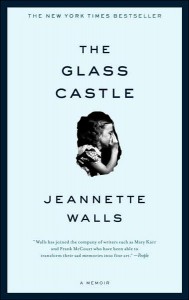 I try to review every book that I read, even if it doesn’t have anything to do with the general themes of this blog like sports and pop culture. But the incredible success of my review of the Glass Castle shows that maybe, just maybe, I should review literally every single thing I experience. Not just books, but music, food, furniture, public transportation, whatever. Although it is the second-most recent post on this list, it’s garnered far and away the most views at 1,106 and counting.
I try to review every book that I read, even if it doesn’t have anything to do with the general themes of this blog like sports and pop culture. But the incredible success of my review of the Glass Castle shows that maybe, just maybe, I should review literally every single thing I experience. Not just books, but music, food, furniture, public transportation, whatever. Although it is the second-most recent post on this list, it’s garnered far and away the most views at 1,106 and counting.
“I never thought that I’d enjoy Jeannette Walls’ "the Glass Castle", but I was wrong.
On the surface, it looked like it was more for stay-at-home moms. It was one of Heather’s Picks at Chapters-Indigo Bookstores and reeked of Oprah’s Book Club. But once I started reading it I appreciated Walls’ writing and was moved by her story.
Like Frank McCourt’s ultra-popular Angela’s Ashes, the Glass Castle is a dark memoir about a dysfunctional family crippled by the father’s alcoholism and the mother’s loose grip on reality.”
Top 10 ideas the National Hockey League should institute
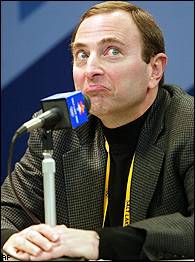 With the National Hockey League’s 30 general managers currently meeting in downtown Toronto to discuss changes to rules and policy, I figured I’d take the opportunity to chime in with my two cents. Times 10. My 20 cents, if you will.
With the National Hockey League’s 30 general managers currently meeting in downtown Toronto to discuss changes to rules and policy, I figured I’d take the opportunity to chime in with my two cents. Times 10. My 20 cents, if you will.
Lengthen overtime
Extending overtime is already on the table as the GM’s try to cut down on the number of shootouts, but I wanted to voice my support for this idea.
Right now, the extra period is just five minutes of 4-on-4 followed by the shootout. OT is the tensest period of play in any hockey game with each penalty, missed pass or deflected shot putting the game on the line.
There’s been a lot of talk of having five minutes of 4-on-4 and then five of 3-on-3. The former doesn’t really strike me as too interesting - I don’t see why they couldn’t just do 10 minutes of 4-on-4, or, what the hell, a full 20 minutes of 4-on-4 followed by the shootout.
It’ll still cut down on the number of shootouts and will create more tension and therefore more excitement. Fans tend to enjoy excitement.
Get rid of archaic blackout rules
As I’ve mentioned before, my fiancée Katy and I are a mixed couple – I’m a Leafs fan and she supports the Oilers.
It makes for the occasional tense moment, but what really aggravates things is that we can only watch the Leafs and rarely the Oilers thanks to the NHL’s ridiculous TV blackout rules. This regulation prevents anyone with a standard cable package from watching an out-of-market hockey game.
In other words, although Sportsnet West was carrying the Edmonton-Carolina game last night, we could only watch the Toronto-Tampa Bay match or the Washington Capitals-New York Rangers game. I understand the original reasoning behind this rule was to keep fans interested in their hometown markets.
However, this hurts the NHL more than it helps. If a fan in Minnesota wants to cheer for the Pittsburgh Penguins, then so be it. Associating yourself with frustrating rules that limit your fans ability to watch your product is never a good idea. Dropping this ridiculous regulation would also tie in with…
Embracing fantasy hockey
I think we can all agree that the National Football League is the best run professional sports league in North America and arguably the world. So why not tear a page out of their playbook and embrace fantasy sports?
In addition to showing the scores from games, the NFL runs tickers of the top five stat lines from each position during their Sunday broadcasts. That running update on the individual success of its players is aimed straight at fantasy football managers eager to see how their personal team is doing.
The NHL should do likewise: run a ticker with the statistics of the top five forwards, defenders and goalies each and every broadcast night.
Clamping down on vague “lower body injury” reports would be a good idea as well. Force the teams to reveal more details about their hurting players for the benefit of fantasy hockey managers. Anything to make fantasy hockey more accessible and enjoyable.
Show where shots are coming from and going
This has long been a bugbear of mine. During games broadcasters will happily tell you how many shots a goalie has faced. That’s all well and good, but not all shots were created equal. A shot from the slot is a lot more dangerous than one from the blue line.
Hockey broadcasts should show where on the ice players are shooting from and where they’re going on net. The technology is already there – Major League Baseball can track the trajectory of pitches and the National Basketball Association regularly shows where players shoot from on the court.
Both concepts should be applied to hockey. It would really help viewers understand the underlying strategies and tactics within a game as patterns begin to emerge in shot selection and location.
Is the defence successfully pushing forwards to the outside? Are they giving up a lot of breakaways? Is the power play unit feeding to the rearguard for big shots, or working it down low? Are shooters trying to pick top corners, or shooting along the ice for big rebounds? It would really add more depth and understanding for the average viewer.
No touch icing
The favourite hockey cause of the CBC’s Don Cherry, no touch icing is an idea that is long past due. With increasing concerns about head shots and concussions, why is the NHL persisting in having a rule that routinely has two players racing the full length of the ice toward unforgiving boards? Just take it out of the game already!
Crossover playoffs
The NHL has a lengthy and rich history, particularly amongst its storied Original Six franchises.
Unfortunately, thanks to their current playoff system, many of the oldest rivalries in the game will never be put on the league’s biggest stage: the Stanley Cup final.
The Montreal Canadiens and Toronto Maple Leafs, the biggest and best feud in all of hockey will never play with the NHL championship at stake again. Neither will the Chicago Blackhawks and Detroit Red Wings or the Habs and Boston Bruins.
My solution is actually an old idea: have the top 16 teams in the league in one playoff pool. President’s Trophy winner will take in the 16th seed, the other conference champion will take on No. 15, and so on. It’s how the playoffs were structured in the 1970s and 80s, and it’ll work again today.
Get back in touch with the history of the game
Other than the MLB, there is no major North American sport that has as rich a history as the NHL. Unfortunately, commissioner Gary Bettman clearly sees this as a weakness and tries to cover up or even undo a lot of the league’s historical underpinnings.
This is a mistake.
By shying away from that history it makes the NHL seem like a new, fly-by-night operation, particularly when franchises are being parachuted into Sunbelt markets that are unfamiliar with the game.
The NHL should embrace its past with throwback jerseys, prominent marketing of its namesake trophies (like the Lady Byng) and make sure to compare today’s stars with some of the legends of hockey. History and tradition are strengths, not weaknesses.
No more two-piece sticks
Look, I’m all for innovation. I’m not some Luddite who poo-poos every new idea. But let’s get real: two-piece hockey sticks break a lot more than good ol’ fashion wooden sticks.
Not only is this dangerous to players, linesmen and potentially fans, but it slows down the game as the remnants of that $200 fibre composite is cleared off the ice. If an all-wooden stick was good enough for Al MacInnis’ record holding slap shot, it’s good enough now.
Reinvest in amateur hockey
I don’t actually think that the Sun Belt expansion was that bad an idea. New markets and new fans really can work. It just wasn’t done right.
The NHL should take the time to invest in amateur hockey at the grassroots level because those are the fans – and players – of the future.
Amateur hockey would help educate parents and kids about the sport and create an instant niche market of coaches taking their teams to games.
When moving in to Phoenix, Miami or Atlanta the league should have set up minor hockey systems to introduce those cities to the sport. Obviously, that ship has sailed, but it might help with some damage control if they got local kids involved in the game.
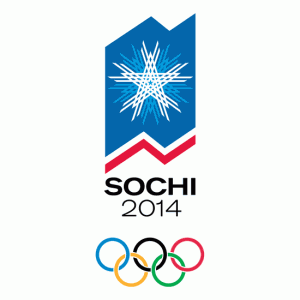 Send NHLers to the 2014 Sochi Olympics
Send NHLers to the 2014 Sochi Olympics
This was, of course, a hot-button debate at the World Hockey Summit this summer, but it’s worth mentioning again.
Bettman and co. must let NHLers play in the Olympics, and they should make that announcement sooner rather than later.
Why? Because although the Stanley Cup and the Winter Classic do a great job of raising hockey’s profile, nothing does a better job of exposing the sport to the masses like the Olympics. Nothing.
This year’s men’s hockey final between the United States and Canada was the most watched hockey game, ever. It drew 44.2 million viewers across North America and was the main event of the two week sporting event.
The NHL would be foolish to give up that kind of mainstream media attention. Bettman should make the announcement soon as well and what better place than this year’s newly reformatted All-Star Game?
What do you think? What ideas do you have for the NHL GMs? Post them in the comment section below.
It’s time for a Women’s National Hockey League
 During the final day of the World Hockey Summit it became abundantly clear that Hockey Canada, USA Hockey and especially the National Hockey League need to become more proactive in the growth of women’s hockey.
During the final day of the World Hockey Summit it became abundantly clear that Hockey Canada, USA Hockey and especially the National Hockey League need to become more proactive in the growth of women’s hockey.
It’s something that has been at the back of my mind since the Winter Olympics in Vancouver last February – how can an exciting game like women’s hockey only really be seen on TV every four years? What can be done?
Outside of the collegiate game in the United States and Canada there is no forum for elite women’s hockey. Even at the amateur level there are many municipalities that don’t have leagues for female players, and at the World Hockey Summit there were stories of towns that won’t let women use the arenas, period.
Further, there is no junior hockey for ladies - although women are allowed to play in the three leagues that comprise the Canadian Hockey League.
At the professional level there have been several attempts at running leagues, including the Canadian Women’s Hockey League that has teams in Montreal, Mississauga, Burlington, Brampton, Vaughn and Ottawa.
The CWHL competes for the Clarkson Cup against teams from the Western Women’s Hockey League. The WWHL has franchises in Calgary, Edmonton, Winnipeg, Strathmore and Minnesota.
Although I admire these leagues ambitions, they’re unstable with teams folding or relocating constantly. Other leagues like them have collapsed under the financial and administrative strains of running a professional association.
This is where the NHL needs to step in, and form a WNHL, much like the National Basketball Association’s WNBA, to market and promote a high-calibre female version of hockey.
Like the WNBA model, all the teams could be owned by the NHL or its franchises at first, and as they become more solvent be sold to third parties. Every team would be associated with an NHL or American Hockey League franchise to guarantee cheaper access to facilities and to enable cross promotion.
It would be an easy sell to have a NHL/WNHL double-bill in several traditional hockey markets like the Original Six, in the six Canadian NHL cities and a few other hotbeds like Minneapolis.
Further, when I threw it out to my Twitter followers last week, reader @katylalonde pointed out that there are several locations begging for hockey like Winnipeg, Kitchener, Hamilton and Quebec City. It would be a smart move for all four municipalities to invite a WNHL franchise to their rinks and prove that their arenas are viable venues for professional hockey.
Of course, such an initiative would have to be supported at the amateur level. Hockey Canada, USA Hockey and regional associations would need to do more to promote the women’s game at the amateur level. But with professionals serving as role models, it shouldn’t be too hard.
This is the kind of program that is prime for implementation - all it would takes is a motivated NHL willing to capture the interest of a whole new market of hockey fans.
World Hockey Summit: Day 3
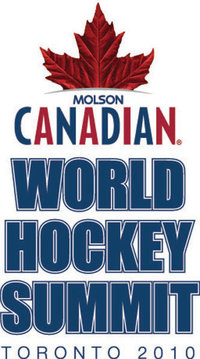 Debate over the National Hockey League’s role in international hockey, especially the Winter Olympics, built to a crescendo at the World Hockey Summit yesterday.
Debate over the National Hockey League’s role in international hockey, especially the Winter Olympics, built to a crescendo at the World Hockey Summit yesterday.
International Ice Hockey Federation President Rene Fasel had started thumping the war drums on Tuesday when he warned the NHL that they would expand to Europe “over his dead body”.
During that same question and answer session with TSN’s Gord Miller he called for professional hockey players to play at the 2014 Winter Olympics at Sochi, Russia.
Wednesday morning there was an evaluation of the 2010 Olympics, with Fasel, Vancouver Organizing Committee CEO John Furlong and International OIympic Committee member Timo Lumme speaking about the great success and popularity of hockey at this year's Games.
All three emphasized that the 114 million worldwide viewers of the USA-Canada men’s hockey final had been drawn, in part, by the fact that it was a best-on-best game that featured NHLers.
After the keynotes were done, Miller, acting as moderator, allowed IIHF member Igor Kuperman, sports marketing guru Brian Cooper, Detroit Red Wings general manager Ken Holland, Ottawa Senators captain Daniel Alfredsson and New Jersey Devils captain Jamie Langenbrunner to respond.
Not surprisingly, all five panellists supported the NHL’s return to the Olympics, with only Holland showing any kind of hesitation. The successful GM had many concerns about scheduling and injury issues affecting the success and health of his professional club.
When discussion broke out amongst the hundreds of delegates in attendance, there was an easy consensus that the NHL and Olympics need each other for the fans and the good of the game.
After lunch, NHL Commissioner Gary Bettman had a Q+A with TSN’s Pierre Maguire. During the interview Bettman repeatedly said there were pros and cons to sending his players to Sochi.
“We haven’t said ‘no,’” said Bettman. “And anybody who suggests that we’ve made a decision or suggests I’m anti-Olympics doesn’t get it, because what we’ve been simply saying is, ‘it’s a mixed bag.’”
Bettman stressed that he was commissioner when the NHL first started playing in the Olympics at Nagano, Japan, four cycles ago and that he has always been interested in exposing the sport to as many people as possible.
Many had expected that Bettman’s half-hour session was going to be the most heated event of the day. However, it was the follow-up discussion of a Global Event Agenda that was really contentious.
Moderated by Darren Dreger, the panel began with a thoughtful presentation by Edmonton Oilers associate coach Ralph Krueger, who had served as head coach of the Swiss national team at the Vancouver Olympics.
Krueger proposed a new schedule for international events, featuring the Olympics every four years, a World Hockey Championship during the intervening years and an under-23 world championship during Olympic years.
He also suggested that the Victoria Cup, an annual club championship between two European teams and two NHL teams, should be revived.
Miller then opened the floor to the panel of NHL Deputy Commissioner Bill Daly, Kontinental Hockey League President Alexander Medvedev, Team USA and Toronto Maple Leafs GM Brian Burke, NHL alum Anders Hedberg, former NHL goaltender and prominent NHLPA member Glenn Healy, NHLPA representative Mike Ouellet and IIHF member and broadcaster Paul Romanuk.
Although things began reasonably as each panellist said their piece, Fireworks ensued when they had the chance to rebut each other.
Generally speaking, Burke and Daly presented the case for the NHL staying out of the Olympics, highlighting that it put teams’ assets – the players – at considerable risk of injury. They were also concerned that the interruption in the professional season damaged the momentum of small-market teams.
“The Olympics don’t hurt the Toronto Maple Leafs, it doesn’t hurt our business model,” said Burke, the former GM of the Mighty Ducks. “But in Anaheim it does. In Nashville, it does. In Florida, it does.”
They were opposed by Healy and Ouellet, who as representatives of the players’ association, felt that their constituency should be allowed to play when and where they wanted, and that practically all NHLers would love to play at the Olympics.
Panellists outside of the labour politics of the NHL like Medvedev, Hedberg and Romanuk also chimed in with their concerns, although all three were adamant that the Olympics should be a “best-on-best” tournament.
The debate laid bare many of the tensions at the highest levels of hockey.
Everything from the ongoing labour disputes between the NHL and NHLPA, the lack of communication between the NHL and IIHF, the competing styles and values of European and North American hockey as well as the emergence of the KHL as a threat to NHL supremacy were all on display.
There were many dramatic moments, including Healy wondering aloud why Burke cared so much about when the World Hockey Championships were scheduled, since the Maple Leafs are always available when the tournament begins in April.
Alliances also shifted quickly in the swirling debate. When a doctor from the IIHF spoke from the floor to correct Healy’s impression that the quality of medical care provided at the Olympics is sub-par, the former Toronto goaltender saw his nemesis Burke leap to his defence.
Similarly, when another delegate called out Burke and Daly saying that it was a simple issue and that he was sick of hearing excuses about NHLers playing in the Olympics, Ouellet and Healy both allowed that it was a complex issue.
Burke was the most energetic debater throughout, taking on all comers from the stage and the floor of delegates, although Daly, Ouellet and Healy were very active as well. It was an exciting and intriguing show that had delegates buzzing for the rest of the day.
Today’s topics will be Women’s Hockey in the morning and Growing Participation. It’s hard to imagine that those panels will be nearly as heated, but you never know.
What’s in a sport?
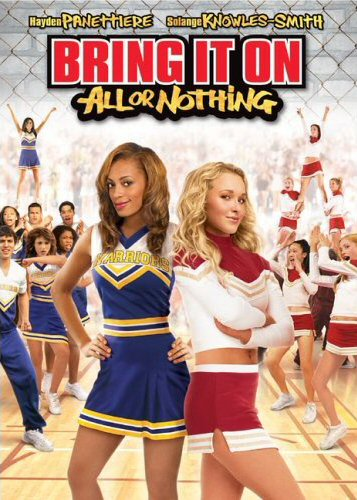 Last week an old chestnut of an argument reared its head when a judge ruled that according to NCAA and Title IX rules competitive cheerleading is not a sport.
Last week an old chestnut of an argument reared its head when a judge ruled that according to NCAA and Title IX rules competitive cheerleading is not a sport.
Quinnipiac University in Hamden, Connecticut had cancelled their women’s volleyball program in favour of the seemingly more lucrative cheerleading team. The volleyball team’s coach sued on the grounds that cheerleading doesn’t meet NCAA rules or the Title IX law.
Using those standards the judge ruled that volleyball is more of a sport than its peppy replacement.
Almost immediately there was an outcry from the cheerleading community, crying foul and defending the honour of their beloved athletic pursuit. This brings us to that previously mentioned chestnut: what constitutes a sport?
Hampton Stevens wrote a well-considered response to the debate for the Atlantic’s website today. He argues that cheerleading is not a sport because the winners are decided by a subjective judging system.
In Stevens’ mind there are three qualities to a sport:
- People compete at it.
- Computers can't do it.
- Aesthetics don't count.
He cites examples too. Chess is not a sport because computers can play it. Croquet is a sport though, because there is a clear objective measure of the winner.
I agree with Stevens in principle. In fact, a source of much acrimony in my household this winter was my ongoing criticism of several of the “non-sports” at the Vancouver Olympics.
Like Stevens, I place a great deal of importance on the objectivity of the activity. As soon as judges are holding up signs with scores, I lose interest. However, even I can see a glaring omission in Stevens’ argument: boxing and other combat sports regularly go to a judges’ decision.
If there’s a close match, the judges have to decide the bout based on who dominated the fight, particularly which boxer landed the most head shots on their opponent. In other words, they have to decide how well each pugilist boxed. They have to judge the match on the aesthetics of each fighter’s strategy and style.
Judges miss landed blows and there’s often some interpretation of what is and isn’t a head shot. Also, we’d be kidding ourselves if we thought boxing judges were not corrupt or biased.
I’m not saying that boxing is as subjective as cheerleading or figure skating, but I think it’s important to acknowledge that all sports have a certain aesthetic aspect to them – even in the most cut-and-dry sports like sprinting judging can play a significant role in false starts and photo finishes.
That said, Stevens and the Connecticut judge are both right: cheerleading is far too subjective to be considered a sport.
Twitter buzz - While writing this article I posed the question to my Twitter followers:
@jchidleyhill Is cheerleading a sport? What constitutes a sport?
I got a few responses from my followers, including:
@rubedawg83 - Competition based on participants using BOTH physical and mental tools. Cheerleading - Yes, Chess & Fishing – No
@ToryBachmann - [...] Yes cheerleading is a sport
@Novinarwriting - Hmm Hard to take 'sports' shows like pool/darts/poker seriously
@twharry - Any sort of athletic activity where you can legitimately pull a groin while competing is a sport.
Floyd Mayweather has the right idea
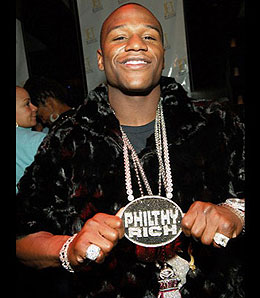 Earlier today it was announced that boxing superstar and WBO champion Manny Pacquiao has agreed to WBC champion Floyd Mayweather’s demands and will submit to random drug screening as part of a deal to make a dream welterweight match happen.
Earlier today it was announced that boxing superstar and WBO champion Manny Pacquiao has agreed to WBC champion Floyd Mayweather’s demands and will submit to random drug screening as part of a deal to make a dream welterweight match happen.
“As long as they’re not getting a large amount of blood, I am willing to give out blood as close to two weeks before the fight,” Pacquiao told the Bulletin late Wednesday night.
This is the second time the two pugilists have agreed to fight; their first encounter was cancelled when Pacquiao refused to be tested for performance enhancing drugs, a procedure that Mayweather insists that he and all of his opponents go through.
Whoever wins this match will be considered the best pound-for-pound boxer in the world. It promises to be an exciting pairing, one that fans of the sweet science have been clamouring for for years.
Some corners feel that this was simply an excuse for Mayweather to duck the seemingly superior Pacquiao. That the drug tests are a stalling tactic by Mayweather to protect his perfect record.
I’m not sure that this is the case. I hope not, because I think that Mayweather has the right idea.
With so many athletes in so many sports testing positive for steroids, human growth hormone or even recreational drugs, many fans are becoming increasingly cynical. Steroid scandals have dealt body blows to the reputations of baseball, cycling and the Olympics.
By voluntarily submitting blood samples to the United States Anti-Doping Agency Mayweather is not just protecting his legacy, but improving the tarnished image of sports.
It’s a breath of fresh air, and particularly refreshing given the sorry state that boxing is in. The sweet science is losing ground to mixed martial arts by the day. This is a sport that has too many titles, too many flashes in the pan.
But Mayweather’s aggressive pro-testing stance means that boxing’s dwindling number of fans, whether they like him or not, at least know that there is some integrity whenever he steps in the ring.
Personally, if I were a professional athlete in any other sport I would be doing the same thing. By getting voluntarily tested on a monthly basis for the duration of my career, there would be no doubt about the veracity of my records.
This is especially topical since disgraced Tour de France winner Floyd Landis revealed to his sponsors today that he has been doping since 2002.
If I were another professional cyclist I would want to guarantee that everyone knew that I was clean, no matter how well I did. A sure-fire way to do that would be to hold myself to an even higher standard than that of by sports’ governing body.
Although the North American legal system relies on burden of proof – that everyone is innocent until proven guilty – this isn’t about laws. This is about regaining the public’s trust and establishing a reputation of integrity. In that respect, Floyd Mayweather is doing the right thing.
The World Cup should be watched with a grain of salt
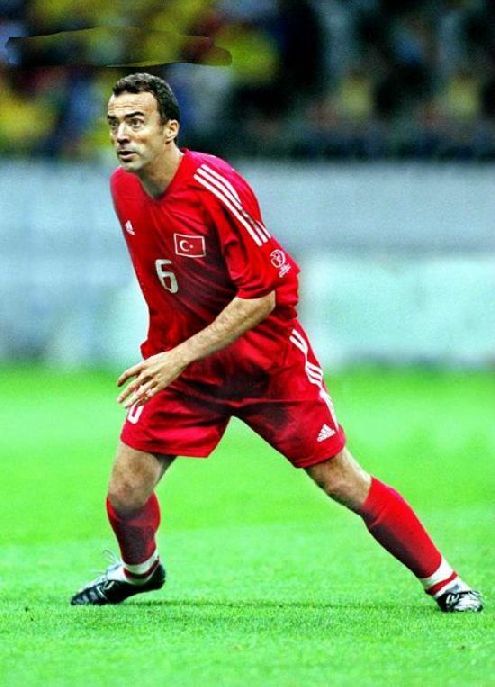
Turkey's Arif Erdem, shown here during his playing days for the national team, was arrested two weeks ago for his alleged involvement in match-fixing.
Although the playoffs (hockey and/or basketball, take your pick) still sit between us and the summer, the Canadian Broadcasting Corporation has already begun to promote their coverage of this year’s World Cup of Soccer in South Africa.
There’s a growing an air of excitement surrounding the tournament. After all, it’s the biggest sporting event in the world, even more popular than the Olympics.
Unfortunately, this time around I’m going to be watching the World Cup with a pretty sceptical eye.
My disillusionment began in Dec. 2008 as I read Declan Hill’s The Fix, an investigation into the world of sports fixing by a journalist who used to work with the CBC and the British Broadcasting Corporation.
I reviewed the book on my now defunct blog, but in short: Hill uncovered a far-reaching criminal underworld that exerts its influence over many sporting events. Hill chose to focus his investigation on soccer matches and his findings were startling.
According to him, there are two kinds of match-fixing scenarios.
1) Internal – When a member of a team gives incentives to officials or the players on opposing clubs to give his team an advantage.
Author Joe McGinniss details this kind of fix in The Miracle of Castel Di Sangro when he overhears several players discussing throwing their final game of the season against Bari. They had been asked to do this “favour” to insure that Bari would be promoted to Serie A.
2) External – When an outsider influences the outcome of a match for personal gain.
Obviously, this is the more typical kind of sporting corruption, with the Black Sox scandal, when the Chicago White Sox threw the 1919 World Series at the behest of Arnold Rothstein, serving as a sterling example.
In The Fix, Hill uncovers evidence of many professional matches being thrown world-wide. The climax of the book is when a mobster assures him that the World Cup itself is fixed. The gangster predicts the results of a handful of matches, down to when the goals are scored.
Hill watches with growing horror as each one of the games ends just as described.
Why is this pertinent now? Because last November German police arrested 15 people for fixing more than 200 games. Two weeks ago, Turkish police detained 40 people, including former international Arif Erdem, for their involvement in thrown matches.
Germany’s Bundesliga and Turkey’s Süper Lig are not the best professional soccer league’s in the world, but they are hardly fly-by-night organizations. In fact, the German national team is one of the best sides in the world and a contender for the 2010 World Cup.
With all this in mind, it will be hard to not be cynical when one of the favourites struggles against an opponent this summer. I simply can’t help but be a little jaded after reading The Fix and hearing about recent events in European soccer.
Canada/USA has made me into a fan of women’s hockey
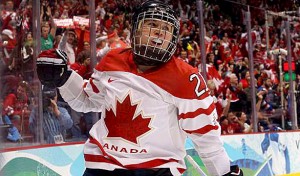 I am embarrassed to admit that last night was the first time I have ever watched a women’s hockey game from start to finish. A terrible sin, I know.
I am embarrassed to admit that last night was the first time I have ever watched a women’s hockey game from start to finish. A terrible sin, I know.
I had seen periods from games or seen bits and pieces, but for a host of reasons I’ve never been able to sit and watch a women’s game to completion. But I’m glad I finally did.
It was the perfect game to watch as Canada held on to an early 2-0 lead to down their arch-rivals from the United States and win their third consecutive Olympic gold medal.
There was a lot to like about the match-up. As the prohibitive favourites in any international tournament, the North American teams had often locked up at the highest levels of competition, whether at the Olympics or World Championships. As a result, the two teams are very familiar with each other’s tactics and strategies.
It quickly became apparent that women’s hockey has a style all its own thanks largely to the prohibition of body checking.
Personally, I’ve always thought this was a sexist rule that implied that women were too fragile to withstand physical play. It just made no sense – why could a woman not safely hit another woman? They would be physical equals, with no particular danger of injury.
However, the lack of big hits means that the scourge of entertaining hockey – the Trap – is impossible. The resulting game is fast and free-flowing with few stops in play. It’s refreshing compared to the National Hockey League where clogging the neutral zone has often been the fastest way to the playoffs.
The players on both teams were exceptional passers and play makers. Throughout the game there were creative tape-to-tape passes generating scoring chances. The Canadians in particular had a knack for finding each other on the ice.
When they had those openings, the Canadians were patient, waiting for defenders to over-commit themselves to a blocked shot. Canada often exploited their opponents’ mistake with a sharp pass for another quality chance. It was inspiring hockey.
Team Canada was also impressively dedicated to defence, dropping to their knees to block shots and passes, fending off a 5-on-3 power play for nearly a minute and a half at the start of the second period.
It was a lot of fun to watch, with both teams evenly matched.
That said, I don’t regret missing any of their other games. They were all lopsided blowouts that made me feel bad for the have-nots in women’s hockey. This is the sport’s greatest weakness – only a Canada-USA match-up showcases the very best of the game. Every other pairing is horribly one-sided.
When the next world championship rolls around, I’ll make sure to watch – as long as the game has Canada and the USA in it.
A side note: The fact that Team Canada had to apologize for their celebratory drinks and cigars on the ice is utter nonsense. The arena had emptied out and they were revelling in their success in what should have been a private moment. They should be allowed to let their hair down, guilt free.
I won’t go on any further, as too much ink has already been spilled over this story.
In Defence of Own the Podium
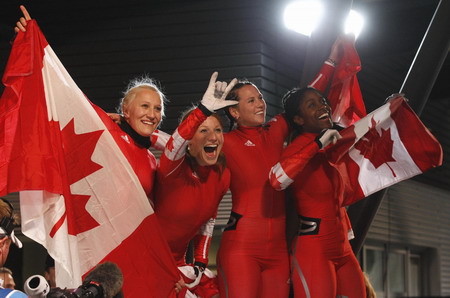 Wednesday was Canada’s best day for Olympic medals, with the teams of Kaillie Humphries/Heather Moyes and Helen Upperton/Shelley-Ann Brown winning gold and silver in a 1-2 punch in women’s two-person bobsleigh. The women's 5,000 metre speed skating relay team earned a silver medal. Adding to the medal haul was Clara Hughes, who earned her sixth career Olympic medal, a bronze in 5000m long track speed skating.
Wednesday was Canada’s best day for Olympic medals, with the teams of Kaillie Humphries/Heather Moyes and Helen Upperton/Shelley-Ann Brown winning gold and silver in a 1-2 punch in women’s two-person bobsleigh. The women's 5,000 metre speed skating relay team earned a silver medal. Adding to the medal haul was Clara Hughes, who earned her sixth career Olympic medal, a bronze in 5000m long track speed skating.
Although Team Canada’s 7-3 thrashing of the Russian Federation grabbed all the headlines, it was a banner day for Canada’s less glamorous Olympic sports that may have helped justify the Canadian Olympic Committee’s controversial Own the Podium program, just as it appears to be on its last legs.
Designed to give Canada the highest medal count at the 2010 Vancouver games, the Own the Podium program increased spending on winter Olympic sports by $21-million annually over the course of five years, with money coming from provincial and federal governments as well as private sponsors like Bell Canada. The goal was for Canada to earn a total of 35 podium finishes.
This plan has drawn criticism from all corners. Other countries (particularly the British media) have described it as an “un-Canadian” initiative. Apparently, it’s against the national character to be competitive in anything other than men’s hockey. A proposterous claim given that the Olympics, by definition, is about pushing the envelope and achieving new heights.
At the same time, some domestic media were unhappy that so much public funding - $118 million in total – was being spent on athletics when it could be applied to pressing issues like education, health care or the flagging economy.
As of this writing, Canada has stepped on to the podium 15 times, and might finish in the top three in men and women’s hockey, men and women’s curling and speed skating. Realistically, Canada will finish with around 20 medals, just shy of their 2006 Turin total of 24, and well short of Own the Podium’s stated goal of 35. On Monday, the COC announced that it was no longer aiming to top the medal tables at Vancouver.
In other words, CEO Roger Jackson and his staff have disappointed just about everybody, except the athletes.
Although the program has not met expectations, I think that in the long run it will make Canada into a more formidable sporting nation. At long last, Canadian athletes are getting the support they so richly deserve, allowing them to finally put their best foot forward in international competition.
Their performance at the Vancouver games will serve as an inspiration to Canada’s youth, spawning a new generation of world-class athletes. Yes, the money could have been spent on other projects, but giving Canadian children role models to look up to is certainly a worthy pursuit.
Further, this initiative is just catching Canada up to the rest of the world. In many cases, the athletes from other nations in the winter Olympics are members of the military.
For example, Tuffy LaTour, the coach of Canadian men’s bobsleigh team, is a retired army sergeant from the United States who competed with the American military’s sledding team.
Dan Humphries, the husband of Canadian gold medalist Kaillie Humphries, and a member of Canada’s four-man bobsleigh team, was originally a member of the British Army’s slidding team.
Heck, Finland won the Winter War against the Soviet Union by their superior biathlon skills.
Canada, with its significantly smaller population and military complex, needs a boost to its athletics programs, and Own the Podium is it.
Just as the Calgary Olympics created a home base for Canadian sports, the combination of the Vancouver games and Own the Podium will start a new golden age in the Canadian Olympic movement. It appears as though most of Own the Podium's sponsors, both public and private, will stop funding after the closing ceremonies this weekend, which would be a shame.
Three ice dancing performances I’d like to see
Like many Canadians, I was thrilled by Tessa Virtue and Scott Moir’s gold medal ice dance performance on Monday night.
I would never call myself a figure skating or ice dancing fan – I find that too often the judge’s decisions are political – but I was impressed with the athleticism and technique of all the dancers in the competition.
What did not impress me was their lack of creativity or originality. Most of the performances bled together. Virtue and Moir stood above the rest of the competition because they didn’t rely on clichéd music like the themes from the Phantom of the Opera or Requiem for a Dream. They weren’t covered with sequins and feathers. Their performance truly distinguished them from the rest of the pack.
As I was watching all the performances roll off the assembly line, I couldn’t help but come up with ideas of my own. Not necessarily for me to perform since I’m a terrible skater, but ideas that talented ice dancers could use to blow away the judges and competition. Here are my top three:
Super Mario Brothers -Mario and Princess Peach.
 The pinnacle of video game romance, Super Mario’s quest to save his true love, Princess Peach, is timeless and crosses all cultures. Their tale of love denied has ties to Japan, Italy and North America and would undoubtedly hold appeal to judges from many nations.
The pinnacle of video game romance, Super Mario’s quest to save his true love, Princess Peach, is timeless and crosses all cultures. Their tale of love denied has ties to Japan, Italy and North America and would undoubtedly hold appeal to judges from many nations.
The music is all there too. Obviously, the symphonic version of the Mario theme is a good starting place, but if the performers want to make things a little more contemporary theys can break it down and use a medley that incorporates DJ Clue’s remix of the classic 8-bit song.
The costumes are easy too – the male dancer would wear red overalls, a red newsie cap, white gloves and a giant fake moustache. Princess Peach’s costume is even easier, since most figure skaters already wear giant pink dresses and crowns. The one adjustment is that for safety reasons the ice dancer’s costume would need a shorter skirt then the Princess’ traditional ball gown.
After all that preparation the performance will write itself. Trust me.
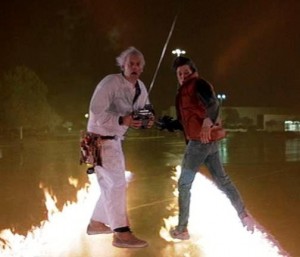 Back to the Future – Marty McFly and Doc Brown.
Back to the Future – Marty McFly and Doc Brown.
Not a love story necessarily, but Marty McFly and Doc Brown have one of the best bromances in movie history.
The strength of the Back to the Future pairing is that the music would blow the competition away. Nothing could top Huey Lewis’ "Power of Love" for the short program (complete with air guitar) followed by Alan Silvestri’s Back to the Future theme for the long performance.
The biggest problem with this program, of course, is that both characters are male. However, a petite brunette with short cropped hair could easily play Marty McFly. Tight jeans, a denim shirt and McFly’s trademark red vest would complete the ensemble. A big white wig and flowing lab coat would transform the male dancer into Doc Brown, and your theme is complete.
Liberal use of a fog machine, and perhaps a Delorian door for the ice pad’s entrance would complete the performance and a much needed sense of adventure to the proceedings. I have it on good authority that you don’t need money, you don’t need fame, you don’t need no credit card to ride the Olympics train.
Star Wars – C3PO and R2D2
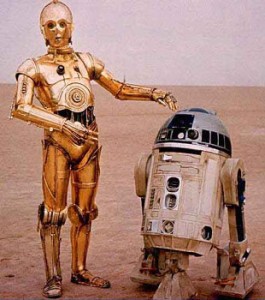 Yes, there are more traditional romantic pairings like Han Solo and Leia Organa, while Luke Skywalker and Princess Leia could appeal to those icky brother-sister ice pairs like Russians Roman and Alexandra Zaretsky or Brits Sinead and John Kerr. However, for my money, the best couple in the Star Wars movies are C3PO and R2D2. They stick together no matter what and have exceptional teamwork. Aren’t those ideal traits for an Olympic-calibre performance?
Yes, there are more traditional romantic pairings like Han Solo and Leia Organa, while Luke Skywalker and Princess Leia could appeal to those icky brother-sister ice pairs like Russians Roman and Alexandra Zaretsky or Brits Sinead and John Kerr. However, for my money, the best couple in the Star Wars movies are C3PO and R2D2. They stick together no matter what and have exceptional teamwork. Aren’t those ideal traits for an Olympic-calibre performance?
Also, the music is a slam dunk. John Williams’ score from the Star Wars movies is one of the most recognizable pieces of classical work and is suitably epic for an ice dancing performance.
I would make my performance an interpretation of the Droid’s journey, beginning with their escape from the Blockade Runner in A New Hope. A bold coach might even incorporate Leia’s desperate holographic message to the Rebel Alliance. As the dancers flee from corner to corner of the ice, extras in Stormtrooper outfits could emerge from the audience to wildly fire blasters at them. It’d be exciting and allow the dancers to display all their most graceful tricks.
The one drawback of this piece would be the construction of R2D2’s outfit. However, I’m sure a talented costume designer could tackle the project and the result would be more dignified then dressing as a tree or performing to Linkin Park’s "Crawling".
